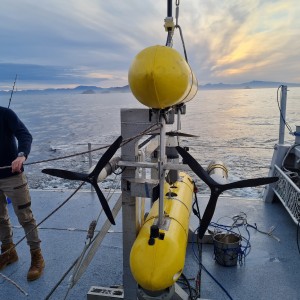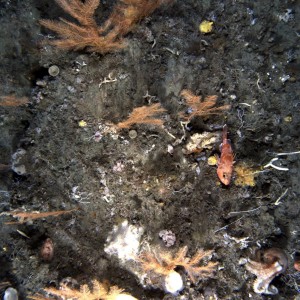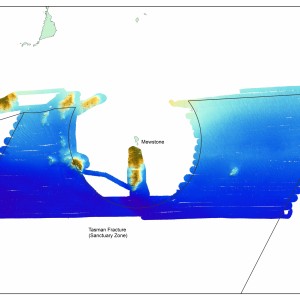In 2009 JASON Remotely Operated Vehicle (ROV) (belonging to the Woods Hole Oceanographic Institution) undertook a voyage in the Tasman Fracture Zone off south-east Tasmania. This is a still image taken at 4006 metres showing deep water stalked carnivorous ascidian (Family Octacnemidae) approximately 50 centimetres in height. The ascidian works similar to a venus fly-trap, using the funnel-like appendage to collapse around prey that move past.
 by CSIRO
by CSIROAutonomous Underwater Vehicle (AUV) "Nimbus" ready for deployment.
 by UTAS/IMOS
by UTAS/IMOSThis benthic community including brittle stars, was captured by on an AUV survey.
 by IMOS, AUV Sirius
by IMOS, AUV SiriusBRUV survey Tasman Fracture Marine Park 2021
 by UTAS/IMAS
by UTAS/IMASExample AUV image from the Tasman Fracture Marine Park National Park Zone showing brittle stars, bryozoans, sea fans, and sponges. There is also a handfish somewhere in there – can you spot it?
 by UTAS/IMAS
by UTAS/IMASExample AUV image from the Tasman Fracture Marine Park National Park Zone showing octopus, ocean perch, sea fans, and sponges.
 by UTAS/IMAS
by UTAS/IMASIstigobius decoratus, known as the Decorated Sandgoby is found on sand patches near reefs.
 by Ian Shaw
by Ian ShawMap of handfish observed in AUV imagery across the Tasman Fracture Marine Park, along with potential species groupings.
 by UTAS/IMAS
by UTAS/IMASThis species of Nototodarus was captured during a BRUVS survey in the Tasman Fracture Marine Park.
 by Jacquomo Monk, IMAS
by Jacquomo Monk, IMASPleurosicya mossambica also known as the toothy goby or the Mozambique ghost goby is found on many substrates, including corals, sponges, giant clams and seaweeds, and can vary colour according to the substrate.
 by Ian Shaw
by Ian ShawA map of the Tasman Fracture Marine National Park Zone, surrounding the Mewstone, that was mapped during the survey in 2014.
 by Institute of Marine and Antarctic Studies
by Institute of Marine and Antarctic Studies












